NOTE: I flew out from Nepal twelve hours before the big earthquake and I left the Langtang area about three days earlier. I started three blog posts before I left: a fluffy one about Kathmandu, this long one about trekking in Langtang and another about practical information doing the trek. While it feels trivial to write about traveling in Nepal since there is so much desperation and suffering in the aftermath, I decided to put these blog posts up anyway for myself, for my own memory. I have an epilogue with some updated information at the end. If you have some new info, please share it!
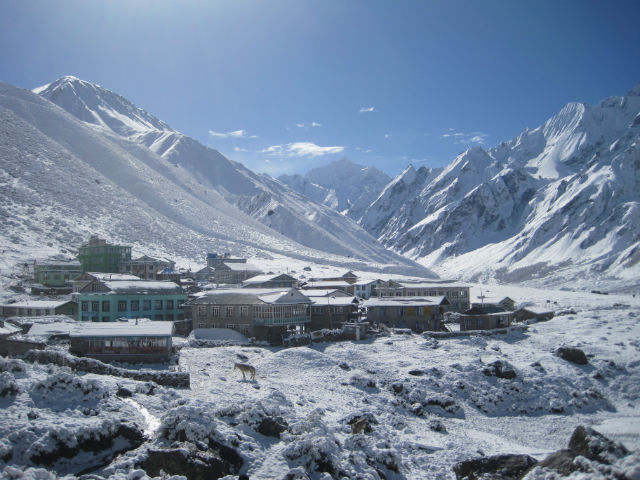
Call me crazy, but I think this looks very pretty.
If I may start by going all granola on you for a moment, there’s something to be said for being amidst such awesome nature where you can see the lay of the land where you have walked all day. Your relationship to the environment around you is intensified—or, in my case, you simply wake up to that fact.
I sat on my balcony in Thulo Syabru, a village sitting on a ridge, and saw the entire day’s walk unfold in front of me: I went steeply up from that river, then along that mountain face, crossed over that looks-tiny-from-here bridge, and came through the terraced land to get up here. I think about this small chunk of land I covered and wonder about all the other chunks of land I have yet to see and how they interconnect. It demonstrates that the resonance of a trek like this is the reason it becomes the highlight of anyone’s world trip and why we travelers return again and again to Nepal.
That’s my last deep thought, don’t worry.
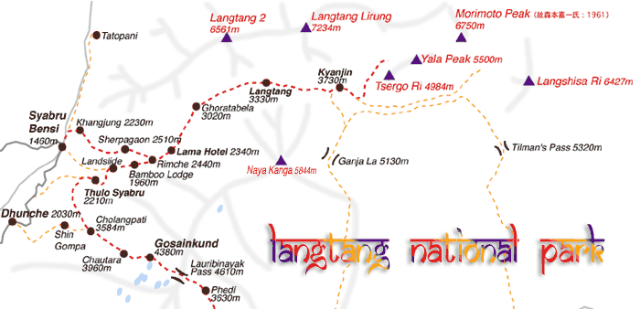
My trek was about a week. I basically only did Langtang: Syabru Besi up to Kyanjin Gompa where I took a wrong turn trying to climb Kyanjin Ri, and then I backtracked a little and walked out on a new-ish route via Thulo Syabru to the road at Thulo Bharku which is before Dhunche and not on this map. I didn’t go over Gosainkund and down through Helambu because of the weather and the time. (If I did, it appears I would have been right at the pass at Laurebinayak during the earthquake.) I read that it is 31km to walk from Syabru Besi to Kyanjin Gompa, but can that be true?
I wanted to get out of Kathmandu before Nepali New Year began, so I had one day to get a permit and everything I needed. I dutifully got trekking pants and iodine pills, but I left it until the end to think about real shoes or a real jacket. When I did the Annapurna trek I was also in a hurry and I somehow bought a giant woman’s jacket. This time I accidentally bought giant woman’s pants which matched nicely with my absurdly inadequate mesh running shoes and windbreaker.
At Syabru Besi, the starting point, I thought of my friend Stephen, who is still my friend despite insisting that I didn’t need a jacket at 4000 meters. Syabru Besi is just under 2000 meters, and I was freezing already. I didn’t see anything to buy in the village, so I started the trek anyway, hinging all my hopes on dry, mellow weather.
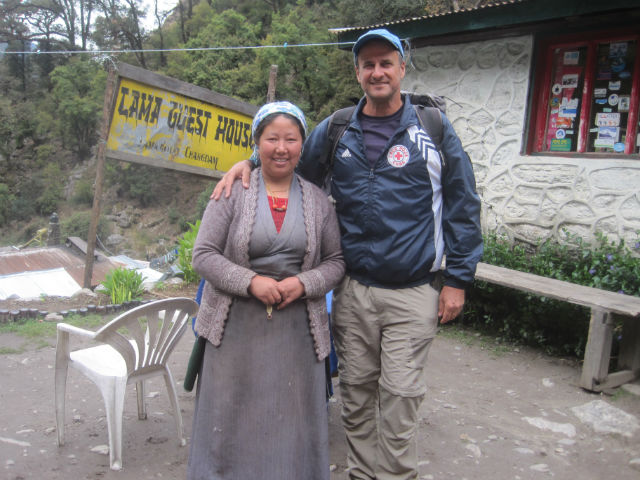
I made it to a place called Lama Hotel, which is not a hotel, but a settlement of small hotels, and stayed at Lama Guest House. What I didn’t know about this trek was that the communities from Syabru Besi to about Lama Hotel are mostly ethnic Tamang, while from Lama Hotel up to Kyanjin Gompa it is largely Tibetan. (As the raven flies, Kyanjin Gompa is only about 5km from Tibet.) The Tamang and especially the Tibetans, I also discovered, have a quick wit and a keen sense of humor.
This firecracker of a woman running the place, Lapka, asked how much credit was on my phone because she wanted to make some calls in exchange for charging it. She also wanted a little boy to play games on it, which he did with gusto by just randomly clicking buttons. I didn’t think anything of it but saw later that he tried to call Denmark.
I was freezing at Lama Hotel even in the relative warmth of the afternoon. I dreaded going higher and asked a father and son tandem coming down if I could buy a fleece or a long-sleeve shirt from them. Mark and Reed from Bellingham, Washington gave me just what I needed and refused payment. I, in return, gave away my treasured Chinese coconut sunflower seeds (the one product we can’t seem to import from China) but I don’t think they got the better of the deal.
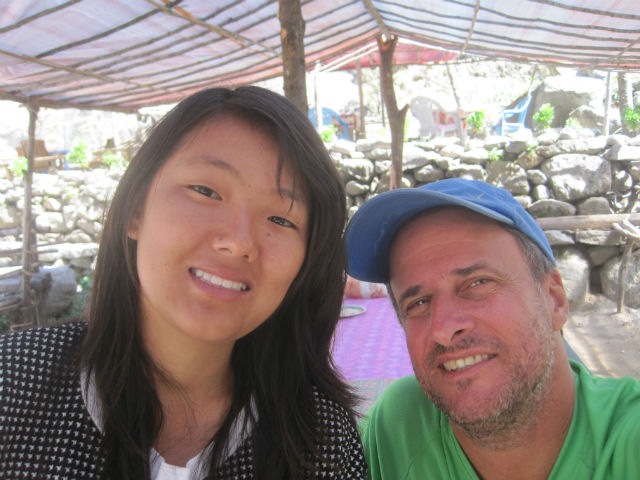
It’s not every day, nor every other day, that a 14-year-old girl asks me to marry her. It started as the ingratiating patter of a salesgirl who wanted me to sponsor her schooling, though it does belie the fact that Nepal is a desperately impoverished country. I heard a couple of stories of foreigners who have trekked up here and found themselves marrying local girls. Even if the stories are apocryphal, it enables the dream of being whisked off to the perceived riches of the West.
I often get people trying to matchmake for me in developing countries and even several times on this trek, but it still came as a surprise to hear her lower her voice and earnestly start telling me that it’s OK for us to get married despite the big difference in our ages.
I was slow to the gravity of her words but struck by her seriousness. I asked, “Why do you want to get married to me?”
She replied, “Because the sky is high.”
I tried to catch up to the fact that I was having a grown-up conversation with this young girl. I said, “The sky is high? What do you mean?”
She gave an enigmatic, beyond-her-years smile and repeated, “Because the sky is high.”
Usually I am quick to digest unusual situations but I was dumbstruck. We talked more, but she became embarrassed and wanted to change the subject. I suggested she marry a guy closer to her age someday, but she just wanted to stop talking about it and said unconvincingly, “I will fulfill your wishes.”
At lower elevations my timing was perfect: the rhododendrons, Nepal’s national flower, were in full bloom. Big bursts of white, red, and pinks almost made up for the fact that nearly the entire trail is covered in horse/donkey/yak/buffalo dung. No one ever mentions that for most of the Langtang trek you are tiptoeing around dung.
Though the national park is called Langtang and the biggest village is Langtang, it’s the next place, Kyanjin Gompa, that’s the magic—if you have clear skies. In Langtang I bought yak cheese and visited a doctor at an Aussie clinic to ask how much I can ascend in one day before I put myself at altitude sickness, and just beyond I saw an enormous, magnificent griffon vulture.
You don’t really see the best of the Langtang trek until you are at Kyanjin Gompa, the last settlement. This is a video of me being overenthusiastic about my surroundings after a night of snow. I don’t see much snow and mountains in my follow-the-sun life. Cut me some slack.
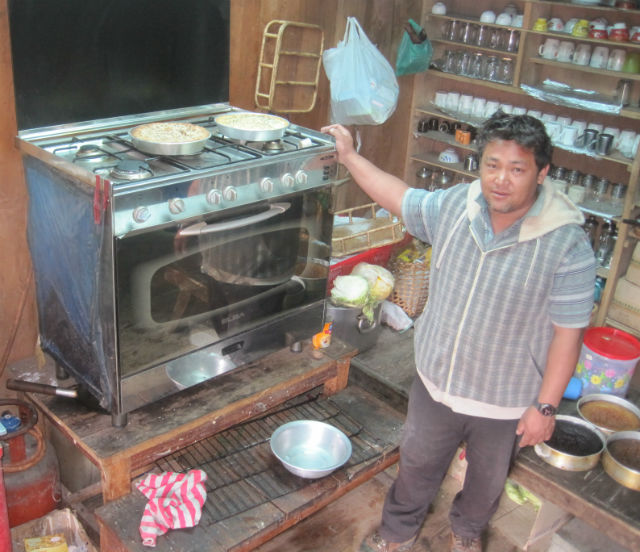
When I first laid eyes upon Kyanjin Gompa, in front of me was a building with DORJE BAKERY written on the roof. I made a beeline there, walked straight into kitchen, passing the “Do Not Enter” sign I didn’t notice, and saw Lhakpa next to his oven— with a six-burner stove!—surrounded by cakes. Lhakpa said he carried the oven for seven days with two other guys all the way from Syabru Besi.
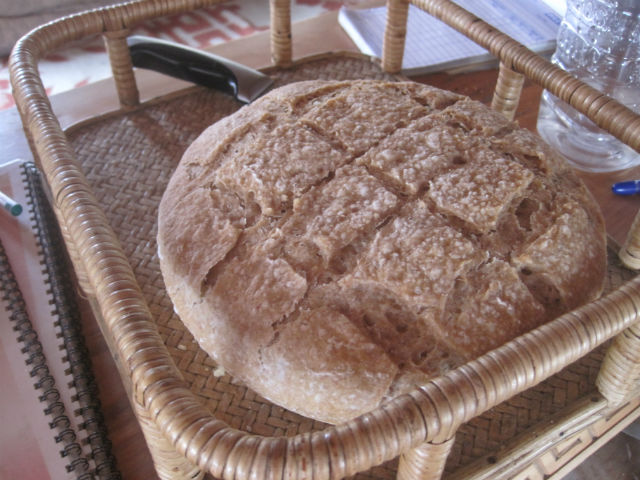
Lhakpa said an American showed him how to make sourdough bread using the local whole wheat. He calls it Tibetan sour peasant bread and it is life-affirming. Lhakpa might be something of a local tycoon, mainly for selling his sublime cakes, pies and bread. I must have spent enough to send his kids to boarding school in Switzerland. He has ambitious plans, first of which is to build a sauna.
Dorje Bakery is like a community center. It’s the only food business on the entire trek that I saw that isn’t a guest house as well, which causes problems because when you pay for your room (or get it free, in fact) the deal is that you eat dinner and breakfast there, too.
In the bakery I met a 20-year-old Canadian girl from Revelstoke named Jenna. She decided on a whim to go up to Kyanjin Ri, which is over three hours round trip, but she was leaving without carrying anything—no sunscreen, no hat to protect her from the intense sun, nor any water (“I can eat snow!”) That’s hardcore. That might also be dangerously irresponsible.
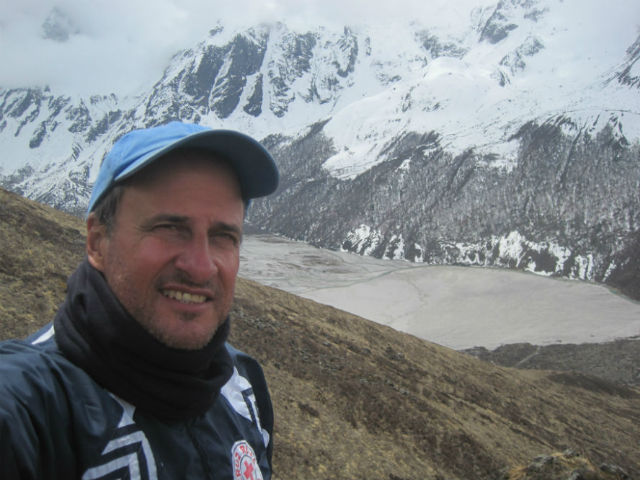
I got lost going above Kyanjin Gompa trying to get up to the viewpoint at Kyanjin Ri, so I can only estimate that the highest I got on the trip was about 4200 meters, which is about 14,000 feet. I’ve been higher. On the Annapurna Circuit I was at 5400 meters. The second highest was probably near the Chile/Bolivia border at 4900 meters and the third highest I’ve been was a long weekend in Amsterdam in 2002. (The joke that never gets old!)
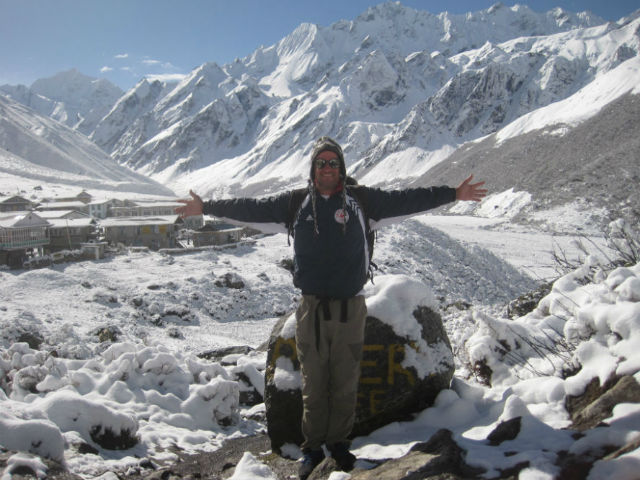
I decided to head out from Kyanjin Gompa in this beautiful weather. Right after this photo was taken I took three steps and fell on my butt. I turned around and waited for the snow to melt more, taking refuge in the bakery with an almond cake.
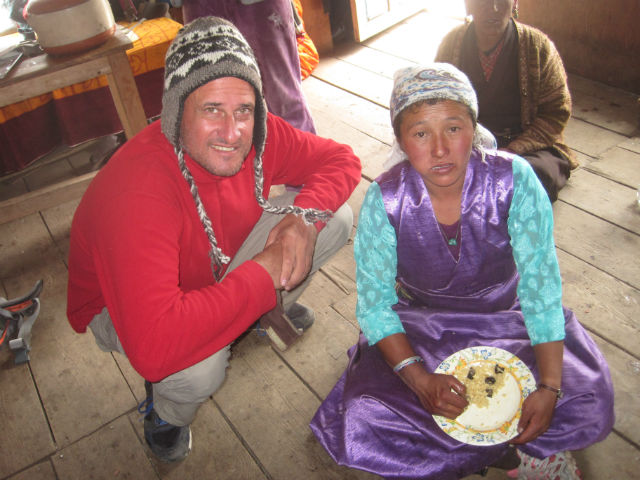
Diki, I’m sorry I’m using this horrible photo of you! It is the only one I have! Since I wasn’t in a hurry and I had the wrong shoes for inclement weather, I stopped when it rained, and I found myself stuck with gregarious Diki at her place in Chyamki, Hilltop Lodge which is about an hour before Langtang village.
I suppose that the line between haves and have nots in the mountains is whether or not you live on a major tourist trekking trail, but I imagine everyone has a hardscrabble life whether you are dependent on tourists for the few short months of high season or not, so I didn’t bargain hard for anything. While I was inside warming myself by the stove, Diki was out gardening in the biting rain. Does the $2 or $3 I’d save by bargaining mean more to her or me?
Look at our burnt faces. High elevation will do this. I brought two tubes of sunscreen but was lax about using it—and I didn’t think of leaving my extra with them on the way down. I tell you, I’m as dumb as a doorknob sometimes.
At Hilltop Lodge I met a nice and sweet Israeli couple who also stayed put for the day and we hung out for a long afternoon of good conversation by the fire in the restaurant. They were very kind, inquisitive, and gentle and I am belaboring the point because Israelis have a fierce reputation for being what I call scorched earth travelers; when they pass through they leave a trail of destruction and bad feelings in their wake.
Some guest houses refuse Israeli travelers altogether. I heard that on the Annapurna Circuit it is quite common. A local told me that Israelis sometimes don’t pay their porters in full when they arrive, which, if true, is the ultimate sin. Porters are the unsung heroes of the mountains, without whom nothing would exist.
Such is the Israelis’ reputation that when I was in Dorje Bakery one morning and saw a guy cooking noodles on a portable stove in the middle of the wood floor, I assumed he was Israeli, because that’s chutzpah. He was French. (Another local told me that the French are the new Israelis.) After he was done cooking he found time to insult the owners when he saw that they were less than happy about it, though they didn’t say a word. He also loudly held forth with his friends that dal baht shouldn’t cost more than 400 rupees (US$1 = 99 rupees) in Langtang, though rice and lentils have to be carried up and firewood isn’t cheap. I’d like to see him carry it all up. I hope in his next life he’s a porter, the bastard.
However, let me say for the record that all but this one French guy and all the Israelis that I actually interacted with were kind people, not one mass murderer among them. I should also say that I didn’t demand to see ID from the jackass. For all I know he could be Swiss or Quebecois, so I, as a typical peace-loving American, am just here to recklessly perpetuate stereotypes.
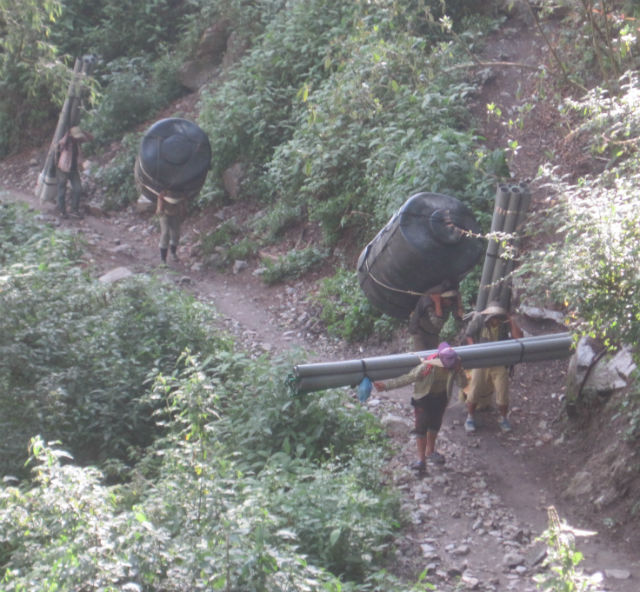
Look at some of these loads the porters have to carry, often in flip flops. It’s remarkable to think that EVERYTHING has to be schlepped up the mountain on the backs of these supermen and women. That’s a rough life and one I’d guess few would choose if they had other options. It’s especially sad to see women and gray-haired men on the trails. It’s sad to see anyone doing it, especially in places where there are donkeys or roads.
The Israelis had a guide. He told me that he was going to be marrying a German woman in three months. He was part of a rescue team that saved her during last year’s Annapurna disaster and in her appreciation she said she would marry him. He didn’t seem to want to get married, but accepted that his life would improve and was going along with it.
I imagine that my first marriage will happen that way: “Dude, thanks for performing the Heimlich maneuver on me. I shouldn’t have eaten that 56th steamed buffalo momo. Let’s get married. Neither one of us is gay, but in California it’s OK. Come on, before I change my mind.”
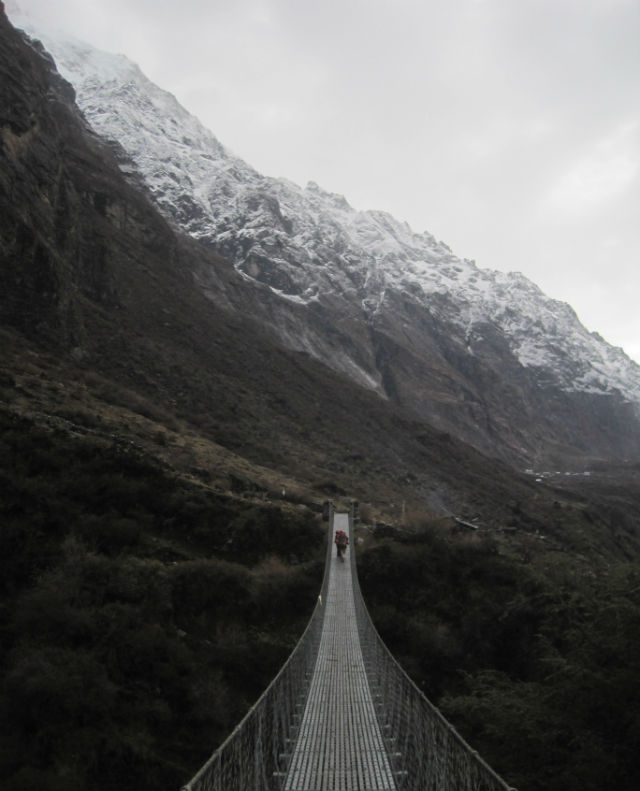
One of several bridges on the trek. My camera sucks.
A big change is coming to Kyanjin Gompa: electricity. For now it is all solar, but a Hong Kong philanthropist named Michael Kadoorie is allegedly going to bring inexpensive electricity in three months. He built a bridge like the one above six months ago. When I asked a local why he was being generous to Nepal when there are other poor places in the world such as India, I was cut short. “India is rich!” he snapped. “Nepal is poor!”
The coming electricity should mean people will use less firewood for their adobe stoves. A man in Kyanjin Gompa explained to me that to get a bushel of firewood delivered—about 12 good-sized pieces—costs 400 rupees but then you are obligated to feed the porter dal baht (rice and lentils) twice and give him raksi, the local distilled firewater. By then, the cost has risen to over 1000 rupees. He was looking forward to electricity.
Lhakpa in Dorje Bakery doesn’t think electricity is going to be a big deal, but I told him if I come back this time next year, the sign on the roof will be blinking in neon and Xmas lights and a casino will be downstairs. He said he intended to build his own hotel—five hotels are already being built; lots of heavy rebar is being carried up at 9000 rupees per porter—but he was grappling with providing wifi. He said most travelers tell him they don’t want wifi, preferring the ambiance without, but I said those people are either lying or old and few can resist it. I was content without it, but I’m old. And I’m lying. Lama Guest House had a laptop hooked up to a battery and kids were watching horrible TV shows, destroying the mood.
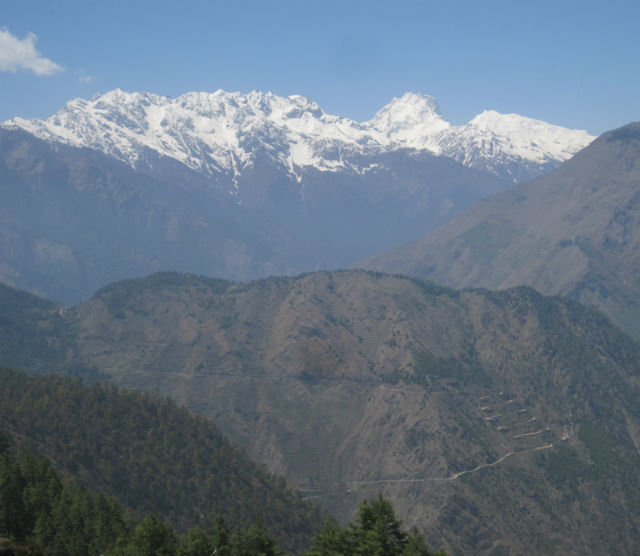
Ganesh Himal mountain range from Thulo Syabru. Just look at that! This is looking westward at the start of the Tamang Heritage Trail, which piques my interest to do next time. When the weather is clear in Thulo Syabru you can see three dramatic mountain ranges.
I pushed myself too hard coming down the mountain. I didn’t rest enough. I am not good at pacing and I overexerted myself to stay in lockstep with a porter. Never mind that he was carrying two large gas tanks on his back and texting as he descended steeply. After hours and hours my knees became spaghetti as I stumbled into a settlement called Bamboo. I was so exhausted I slept over eight straight hours, a great rarity, which probably hasn’t happened since that Amsterdam weekend (rimshot!)
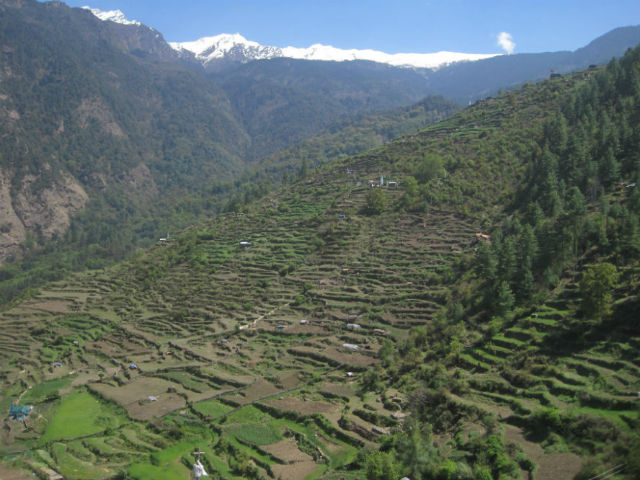
The view from Ganesh Himal Hotel in Thulo Syabru. The weather was so clear I stayed a second day for no reason other than to stare at this all day.
In Thulo Syabru I met an Aussie guy named Tyrone who had been in the mountains for two weeks, starting his walk from downtown Kathmandu. He was so tired of not having fruit that he walked two hours down and two and a half hours and 1000 vertical meters up just to go to town and buy a bunch of bananas! He said he spends $10 a day on the trail, always negotiating a free room in exchange for eating dinner there, but not breakfast, which is usually part of the deal. He had no immediate intention on leaving the mountains, and I could see where he was coming from; I regretted returning to Kathmandu minutes after I got back.
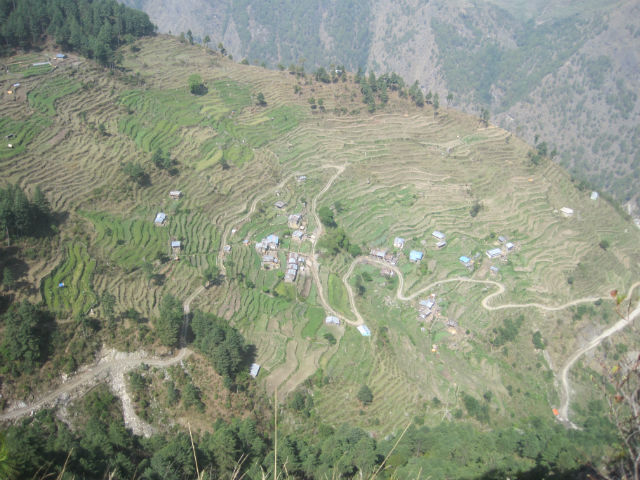
Do you know how much work it is to turn a mountain into endless terraces like this just so you can grow crops? It’s unbelievable. Philippines and Indonesia are known for this to grow rice, which is always spectacular, but the scale of the terracing done in Nepal is unbelievable. I wonder if it is good or bad in an earthquake.
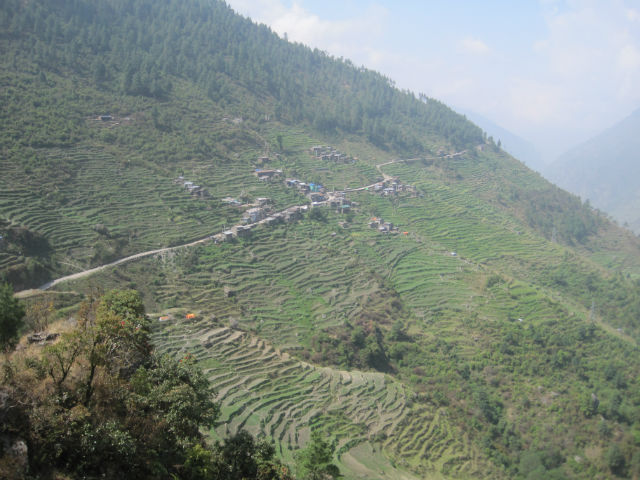
Right at the end of the trek, I took a newer, less traveled path (I saw one person on it the entire morning) to go from Thulo Syabru to Thulo Bharku in the middle of this photo, which is on the road between Syabru Besi and Dhunche. I got a ride hitchhiking with the first vehicle that passed to Dhunche, and then I got stuck until some people I met on the trek saved me. The next day there was this bus disaster on the same stretch of road I was on, but the real surprise is that it doesn’t happen every day.
In the next blog post I break down everything I brought to show that you don’t need to carry so much to require a porter. For example, you really don’t need a sleeping bag. Or food. This is what makes Nepal special and unique: you can independently hike for very literally months and months without much backtracking and explore the country while always having shelter and hot food to eat. If you can handle rice, potatoes and lentils every day, even better.
EPILOGUE:
While I was heartened to hear from friends I made on the trail that they survived and got out, the bad news has been a beast. Lhakpa from Dorje Bakery in Kyanjin Gompa lost his mother, I read, and he sent me an email saying many other family members died and he is suddenly homeless in Kathmandu. Tsering at Ganesh Himal Guest House in Thulo Syabru wrote to say that she and her mother both hurt their legs and her family is also homeless now on the streets of Kathmandu. The 14-year-old girl I met is from Bamboo, where this video was taken. Tyrone the fruit-loving Aussie is still missing.
Langtang village seems to have disappeared. I can’t make sense of what I see as I can’t imagine an avalanche on the scale of what the photos and satellite show here and here. From the BBC is this video and these aerial photos plus this video from a helicopter going up the river, which the trail follows. Here is an account of two girls’ story, this is a reddit from another traveler, and someone sent me this showing the mess in Thulo Sybaru. I read that the doctor I visited in Langtang village, Erin, miraculously was away on a walk when the earthquake hit.
If you are interested in donating money, Erin’s Langtang Valley Health Clinic deserves attention. This is a GoFundme concerning Lakpa of Lama Hotel and Lhakpa of Dorje Bakery. This dude has some wise words about Kathmandu getting the focus of the relief attention, but all the same, I have a contact that I trust and this is her GoFundMe link.
Why don’t you stay with me? You can follow along with RSS, subscribe to an email feed, see what’s cooking on Facebook, pray that I’ll say something worth remembering on Twitter and if you are really slumming it, there’s always Google+. (I’ll follow you back!)

So tragic. I haven’t been to Nepal in years and I’ve been feeling gutted about this; I can’t even imagine how surreal and horrible it must feel to have been there at the worst of it so recently. Such great people who have to work so hard for not much, and now this… It’s all horrific, and that video of the survivor at Langtang was just heartbreaking. Now I’m sad, and wondering about your “sky is high” girl doesn’t help. Sorry to be so depressing; reading all that while knowing what happened was very haunting.
Yes, it’s all awful. I feel lucky to get out but bad that so many people now are suffering.
Your blog post is so very informative. Also, I really respect Andy’s reply. The devastation in Langtang is historically overwhelming and felt worldwide. The enormity is just now sinking in. New to the hiking world, I’m so impressed by the kindness and sincerity of the people described in the valley the day of the quake. They appreciated the beauty of the area, had great hearts & weren’t afraid of a challenge. All of us have to admire them. My family’s thoughts are with them and their loved ones. And, it will be forever. Take care, Mia
Thanks, Mia. If you haven’t had a chance to trek in Nepal, go for it; it’s unforgettable.
Great post. Sounds like you had fun, although it’s always hard to write about a place when a disaster has happened since you were there. I like the story about the girl who wanted to marry you. Also, is that a Hoshi Boshi that you’re sporting in the picture of you and Diki?
I think that the terraces aren’t a big deal in an earthquake, but the level of deforestation required to feed villagers in the hills can’t be good in terms of general erosion and environmental degradation.
I trekked out over Gangja La when I was there, which was a big scenic highlight, but entailed carrying camping gear the whole way to use for only 3 nights. Glad you weren’t on that route during the earthquake!
Thanks, Graydon. I did have a great time.
It is a regular $1 chapeau I am donning, though it is HBL style.
You did Gangja La! I didn’t meet anyone going that way. That would have been amazing to do.
Hi Kent,
Thanks for sharing your experiences in Nepal, must have been hard for you to hear about the bad situation of the great people you met. I am traveling to Nepal on the Oct 01st, I was planning to take a 7 days backpacking trip with a guide, I am a Birdwatchers and would love to see the beautiful birds of Nepal.
I want to do Bardia National Park and some other parks in the lowlands.
I am very much looking for meeting the Nepalis and thee beautiful country.
Take care
Nito
Loved reading your blog. Thanks for sharing. Like you I had been trekking in Nepal (with husband and kids) and had only flown out a couple of days before the earth quake. It’s kind of weird isn’t it, I’ve been reluctant to show off my holiday photos. I guess I should, the Nepalese really need their tourism. We were At Gokyo Lakes but we have previously trekked the Langtang Valley. We spent a few days at Peaceful Lodge in Langtang Village because the owner was so nice and cooked lovely food. I couldn’t get over that BBC footage, so horrible and sad.
I’m not usually to keen to stereotype nationalities, but I have to share this one. My youngest son ordered a bowl of noodles that He found too spicey. He played with it, dribbled into it and left it. An Isreali trekker (who was watching him) took the left overs and put them in plastic bag to eat later in the day!
Thanks again, enjoy your future travelling
Aaaaaahhhhahaha, that’s a funny story!
Thanks for sharing it–although, of course, the guy could have been from anywhere, of course. Of course!
Hi Kent, I greatly enjoyed your report of the trek to Kyanjin though I am very sad about the fate of the friendly people there. After the devastating earthquake this trek will no longer be possible for many years. I made the same trek in April some years ago at the age of 66. I was on my own, carried a bagpack of 7 kilos, had a light silk sleepingbag. Before I had made the trek to Phoksumdo Lake in Lower Dolpo with guide, porters and some friends. A man from Kyanjin made the offer to lead me over Ganja La, but I did not have enough time left what I regretted very much. So I went back via Thulo Syabru to Dhunche. I think I also belong to the dromomaniacs. Seeing your video I experienced that trek again. Many thanks.
Yes, it’s strange to have our great memories be balanced against the great tragedy in the same place. It’s still hard to imagine so much destruction.
That’s pretty brave of you to even consider doing Ganja La! You must be very experienced.
I took the routes you described in December 2012, your description parallels my observations — great place, great trek, great experiences with local people. A good writing that I’d suggest to others to get a superficial understanding of the area — one needs to go there to get a more thorough understanding, but still limited understanding of life in the Langtang valley.
Thanks! I still have it on my mind, I have to say.
I am enviuos. Do I sound too selfish? :):) I know but cant help 🙂
I bet Georgians don’t need a visa for Nepal…